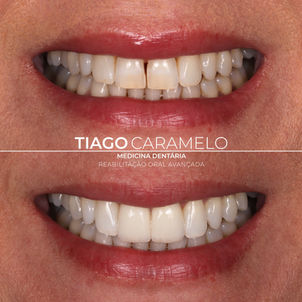Ceramic Veneers
Ceramic veneers – also known as dental contact lenses – are thin ceramic layers, less than 1mm thick, bonded to the outer surface of the teeth. This procedure improves the shape, color, and alignment of the teeth in a highly aesthetic and conservative manner, preserving as much of the natural tooth structure as possible.
It is one of the most sought-after solutions by my patients to enhance the appearance of their smile. Ceramic veneers can correct a range of dental imperfections in a minimally invasive way, providing a natural and long-lasting aesthetic result.

Indications for Placing Ceramic Veneers
Ceramic veneers are recommended for a variety of clinical cases, namely:
-
Darkened or yellowed teeth that do not respond adequately to teeth whitening;
-
Fractured or severely worn teeth due to bruxism or harmful habits;
-
Slightly misaligned teeth, thus avoiding the need for orthodontic treatment;
-
Correction of diastemas (gaps between teeth);
-
Teeth with irregular or asymmetric shape;
-
Teeth that have extensive restorations and require a more uniform aesthetic solution.
Advantages of ceramic veneers
One of the main advantages of ceramic veneers is their ability to provide a natural and uniform smile without compromising much of the original tooth structure. In addition, this treatment offers other benefits:
-
High aesthetics and naturalness – The ceramic material reflects light similarly to tooth enamel, ensuring a natural and sophisticated appearance;
-
Durability – When well cared for, ceramic veneers can last between 10 to 15 years or more, maintaining their integrity and color;
-
Stain resistance – Unlike composite resin veneers, ceramic veneers are highly resistant to stains caused by coffee, red wine, tobacco, and other pigments;
-
Minimal dental intervention – The tooth preparation for the placement of veneers is minimal, making it a less invasive solution compared to other dental rehabilitation options;
-
Correction of multiple imperfections – Veneers can correct discolorations, fractured teeth, slight misalignments, and even close spaces between teeth (diastemas).

Execution of Treatment with Ceramic Veneers
The placement of ceramic veneers involves detailed planning and highly personalized work to ensure a perfect result. The treatment is carried out in three main stages:
1st PLANNING
In this first phase, I perform a detailed analysis of the patient’s smile, taking into account not only the teeth but also the facial structure and lip shape.
For precise planning, several elements are collected:
-
Intraoral and extraoral photographs to assess the smile from different angles;
-
Digital impressions of the teeth to create an accurate model of the dental arch;
-
Radiological exams, such as orthopantomography, to evaluate the overall health of the teeth and gums.
Based on this information, a "mock-up" or a simulation of the final result is made, allowing the patient to visualize their new smile before any permanent intervention.
2nd DENTAL PREPARATION AND PLACEMENT OF TEMPORARY VENEERS
In this phase, a minimal amount of the tooth surface is removed to accommodate the veneers. The goal is to preserve as much of the natural enamel as possible while ensuring a perfect fit for the ceramic veneers.
After preparing the teeth, temporary veneers are placed, which serve two main purposes:
-
Allow the patient to get used to the new smile aesthetics and provide feedback on any necessary adjustments;
-
Protect the prepared teeth until the permanent veneers are placed.
Simultaneously, a final impression is taken, which will be sent to the laboratory where the ceramic veneers will be custom-made.
3rd PLACEMENT OF CERAMIC VENEERS
After about 5 to 7 days, the permanent veneers are ready to be placed. During this appointment, the veneers are tested on the patient's teeth to ensure an ideal fit and aesthetics.
Once the patient approves, the veneers are permanently bonded, providing a harmonious, natural, and durable smile.
POST-TREATMENT CARE AFTER PLACING THE VENEERS
To ensure the longevity of ceramic veneers, it is essential to adopt some daily care:
-
Strict oral hygiene – Brushing at least twice a day and using dental floss are essential to maintain gum and tooth health;
-
Regular dentist visits – Periodic visits are recommended to monitor the condition of the veneers and perform oral hygiene consultations;
-
Avoid biting hard objects – Although the veneers are durable, it is advisable to avoid habits such as nail-biting or chewing pen caps to prevent fractures;
-
Use of a night guard for bruxism – For patients who grind their teeth at night, using a protective night guard helps preserve the veneers.

CONCLUSION
Ceramic veneers represent an effective and minimally invasive solution for those seeking a more beautiful, uniform, and confident smile. With careful planning and personalized treatment, it is possible to transform the smile in a natural and lasting way.
This procedure not only improves dental aesthetics but also contributes to higher self-esteem and confidence when smiling.
If you're looking for a treatment that combines aesthetics, durability, and preservation of dental structure, ceramic veneers are undoubtedly an excellent option. Schedule your consultation to discover how I can help you achieve the smile you've always wanted!
CLINICAL CASES






































